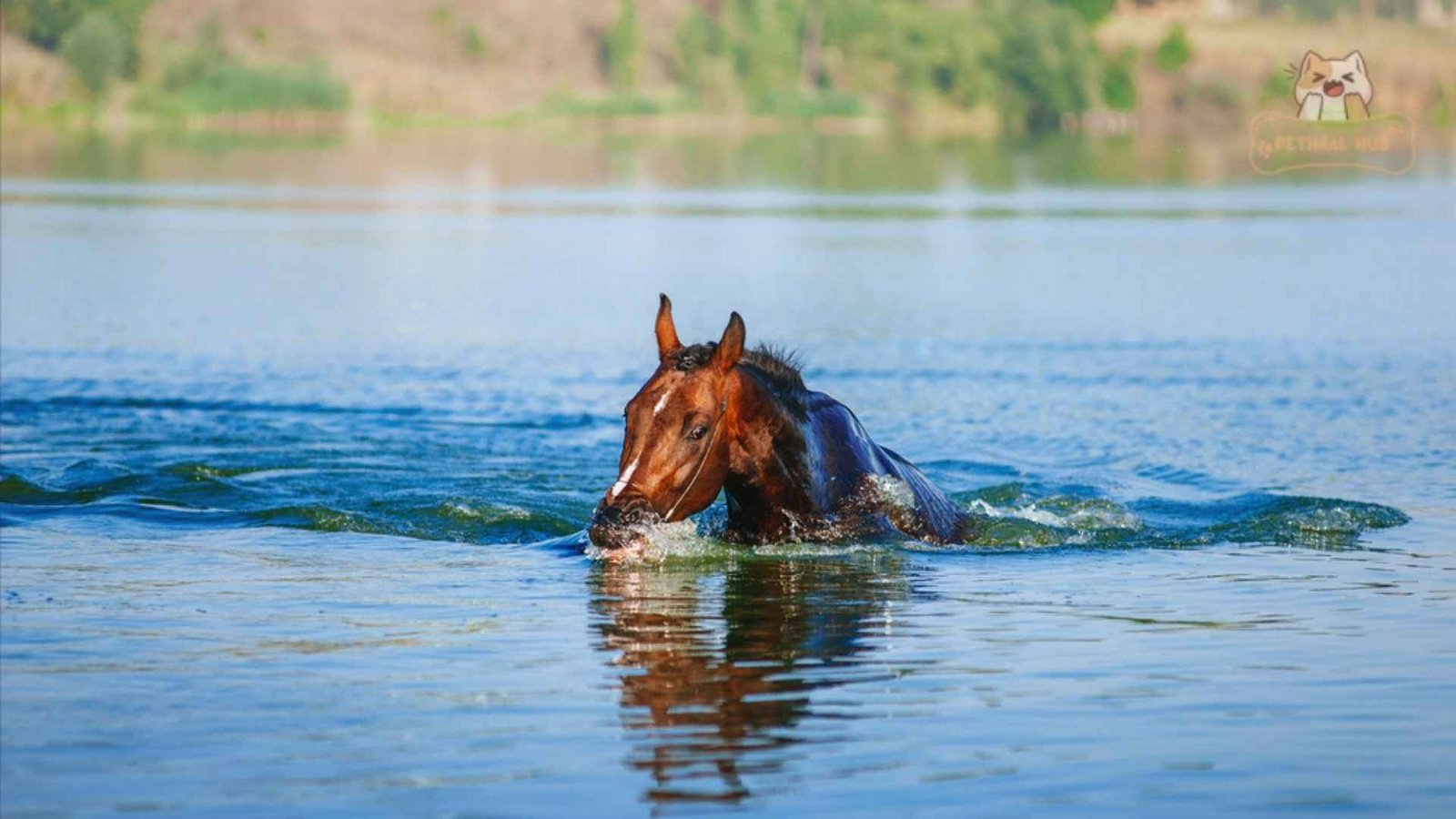
- Blog, Horse
Can Horses Swim?
- February 21, 2025
Horses are naturally equipped to handle swimming, thanks to their strong legs and rhythmic breathing, which help them move smoothly through water. This raises the question: can horses swim? The answer is yes! Not only can they swim, but it also provides several benefits, such as improving muscle tone, enhancing fitness, and relieving stress on their joints. However, to make the experience enjoyable and safe, it’s important to introduce them to water gradually and follow proper safety measures.
Table of Contents
ToggleHow Do Horses Swim?

Horses swim by using their powerful legs in a paddling motion, similar to trotting, to propel themselves forward. Their large lungs help them stay buoyant, while their natural instinct guides their movements in the water. The horse’s body is uniquely designed to handle swimming, with strong muscles working in unison to maintain balance and direction.
While swimming might seem effortless, it requires a great deal of energy, engaging the horse’s muscles in a full-body workout. This makes swimming not only an instinctive activity but also a great form of low impact exercise that improves their fitness without stressing their joints.
Can You Ride a Horse While It’s Swimming?

Riding a horse while it’s swimming can be exciting, but it requires caution. A horse’s natural horse swimming rhythm can be disrupted by the added weight of a rider, making it harder for them to stay afloat and move efficiently.
- Start with shallow water or a pool.
- Always wear life jackets for safety.
- Avoid pulling on the reins.
Also, Read More: How Long Can a Corn Snake Go Without Food?
The Benefits of Swimming for Horses
Swimming offers numerous benefits of horse swimming, providing both physical and mental advantages. It’s a great form of low-impact exercise, allowing horses to build strength, improve muscle tone, and enhance their cardiovascular fitness without stressing their joints. This makes swimming an ideal activity for horses with joint issues or those recovering from injury, as it promotes healing while improving flexibility and endurance.
Full-Body Strength and Tone
The resistance of water helps to build strength and improve muscle tone across a horse’s entire body, providing a full-body workout.
Joint Relief and Flexibility
Swimming relieves joint stress and boosts flexibility, making it perfect for horses with arthritis or recovering from injury.
Our Experience with Horse Swimming

In our experience, taking a horse for a swim is both enjoyable and beneficial. We started by introducing them to a pool with shallow water, allowing the horse to become comfortable with the idea of swimming. The initial session was cautious, but soon the horse relaxed and began paddling gracefully. It was amazing to see how naturally they adapted to the water, using their large lungs and powerful legs to stay afloat.
Over time, we noticed a significant improvement in the horse’s muscle tone and overall fitness. The water acted as a low-impact exercise, which helped reduce strain on their joints and provided a great recovery option after intensive training sessions. Watching the horse enjoy the experience and reap the physical benefits made us realize how valuable swimming can be for horses.
Safety Tips for Swimming with Horses
Safety Tip | Why It’s Important |
|---|---|
Start Slowly | Begin in shallow areas to allow the horse to get used to the water and build confidence. |
Supervision is Key | Always stay close to monitor the horse’s comfort and prevent any distress or accidents. |
Wear Life Jackets | Ensure safety for both the horse and rider in case of unexpected situations in the water. |
Don’t Overdo It | Avoid pushing the horse too hard, as overexertion can lead to fatigue or injury. |
Check Water Quality | Ensure the water is clean, calm, and free of sharp objects or strong currents that can cause harm. |
Conclusion
In conclusion, swimming is a natural and highly beneficial activity for horses, offering both physical and mental rewards. From improving muscle tone and cardiovascular health to providing low-impact exercise for joint relief, the benefits of horse swimming are undeniable. Whether in a pool or deep water, horses can swim effectively and enjoyably when introduced to the activity gradually and with proper safety measures.
Our experience with swimming horses has shown us how this activity can enhance their fitness and overall well-being. With the right precautions, swimming becomes not just a fun bonding experience, but a valuable exercise routine. So, yes, can horses swim? They certainly can—and it’s a rewarding experience for both horse and handler.
FAQs
Yes, horses are naturally capable of swimming. They use their strong legs and large lungs to stay afloat and move through the water. However, not all horses may be immediately comfortable in the water, so it’s important to introduce them gradually.
Absolutely! Swimming is a low-impact exercise that strengthens muscles, boosts cardiovascular health, and reduces joint stress. It’s especially beneficial for horses with joint issues or those recovering from injuries.
Yes, it is possible to ride a horse while swimming, but it requires caution. The water can make it harder for the horse to maintain balance, so always ensure the water is calm and shallow, and never push the horse too hard.
Start with shallow water to allow the horse to get used to swimming. Once they’re comfortable, gradually move to deeper areas. Ensure the water is calm, free from strong currents, and safe for both the horse and rider.
Always supervise your horse, use life jackets for both the horse and rider, and introduce swimming gradually. Avoid overexertion and ensure the water conditions are safe and free from hazards like sharp objects or strong currents.





